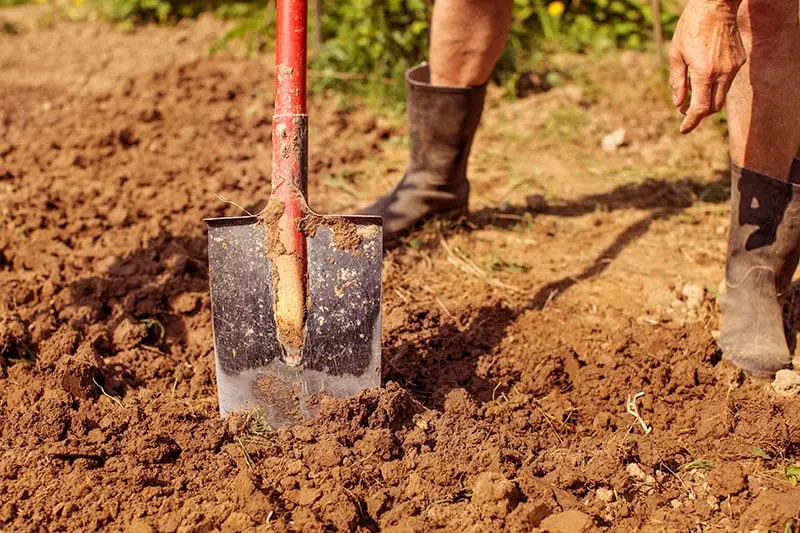Clay soil is all over the United States, including the Southeast, Southwest, and Midwest. Clay soil is one of the most challenging soil types to work with, especially when you want to create a varied landscape on your property. However, you can achieve the landscaping look that meets your vision. It just takes patience, knowledge, proper soil management, and choosing the right plant combination that will grow in clay soil.
How Do You Know if You Have Clay Soil?
Clay soil can be reddish-brown (the most common here in East Texas), deep brown, grey and even white. If you have seen ground in your area under construction, you may have observed distinct layers of assorted colors of clay. When moist, it has a thick, sticky texture that holds its shape.
All soil contains a ratio of three primary elements: clay, silt, and sand. Clay soil features a higher proportion of clay particles, the smallest of the three elements. These particles fit together tightly, which has benefits and drawbacks, especially when it comes to landscaping.
Some of the drawbacks of clay soil include the fact it can get so dense and compact that it will have trouble absorbing water and oxygen resulting in hard, cracked surfaces that end up causing drainage issues. Water will run right off the surface, particularly if you have a sloped yard. Water is also more likely to stand and pool, creating mosquito breeding grounds. Clay soil is incredibly messy, it stains most surfaces. If you have ever stepped in damp or wet clay soil you know it is slippery and sticky. It will cling to your shoe and once it dries in the Texas sun you can compare it to a brick.
While clay soil can have a tough time absorbing water, it also holds tightly onto the water that does get through, making it resistant to drought. However, it can be difficult to find plants that tolerate the fluctuations. On a positive note, it also holds onto nutrients well, helping your plants thrive. Its heavy nature makes it resistant to both wind and water erosion. Despite clay soil, you can still have a beautiful and unique yard full of happy flowers, shrubs, and trees.
What Will Grow in Clay Soil?
Flowers for Clay Soil
• Black-eyed Susans: These sunny yellow flowers with dark centers are native to North America and can adapt to a wide range of soil types, including clay. They attract pollinators and bloom from summer to fall.
• Daylilies: Prized for their adaptability, these flowers come in a variety of colors and, depending on their variety, bloom from early summer to fall.
• Asters: These star-shaped flowers bloom in late summer and fall and come in shades of purple, pink, blue, and white.
• Coneflowers: These drought-tolerant flowers bloom from summer to fall in shades of purple, pink, and white.
• Bee Balm: As their name implies, this fragrant flower attracts bees, butterflies, and hummingbirds. Their unique spiky flowers bloom in shades of red, pink, and purple.
Shrubs for Clay Soil
• Dogwood: Red twig dogwood and silky dogwood offer attractive foliage, flowers, and colorful stems.
• Viburnum: Arrowwood viburnum and nannyberry produce white flower clusters in spring and colorful berries in fall.
• Summersweet: This native North American shrub offers fragrant, white, or pink flowers in summer.
Trees for Clay Soil
• Red Maple: This native tree can tolerate a variety of soils, including clay, and provides beautiful red foliage in the fall.
• River Birch: Known for its attractive peeling bark, river birch can tolerate wet conditions.
• Bald Cypress: This deciduous conifer is known for its feathery, light-green foliage that turns rust-colored in fall.
Improving Clay Soil
Enrich your existing soil. It won’t happen overnight, but adding in organic matter like compost, aged manure, leaf mold, gras clippings, or peat moss will help improve the structure of your soil along with its drainage and fertility. Apply a layer between two and three inches thick and then till it into the topsoil. You can do this before spring and fall planting seasons.
Mulch Magic
Tightly packed clay can take longer to warm up in the spring, making it harder for tender new plants to emerge and begin their growing cycle. Adding a mulch layer around your flower beds, shrubs, and trees can improve temperature regulation, help maintain moisture and deter weeds.
Choose Your Local Clay Soil Experts
If you’ve got especially challenging soil, certain soil amendments like sand, perlite, or gypsum can improve the soil’s structure and drainage. Soil amendments can be tricky to get right, but we can help you.
To improve your clay soil, it takes focus, patience, and time. The process is gradual, and it can take multiple seasons of consistent effort for you to notice an improvement. If you’re struggling to achieve the landscape you want in your clay soil, contact us. We are locally owned and operated so we are familiar with the unique challenges clay soil poses.










